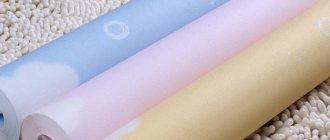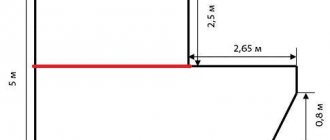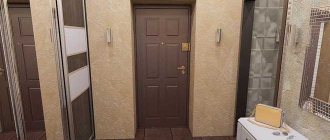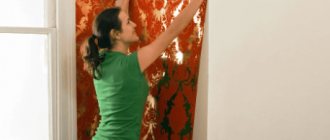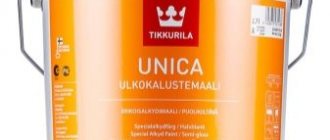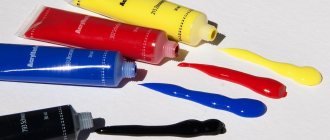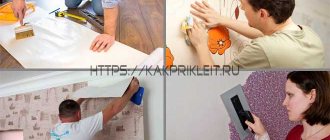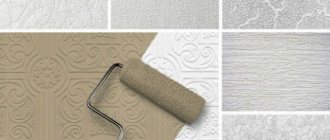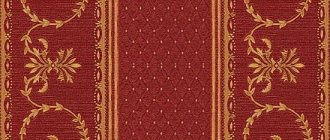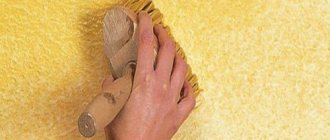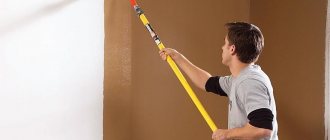Each square meter of wallpaper weighs no more than 100 grams
When renovating an apartment, the last step in decorating the walls is wallpapering. Today's industry offers a wide selection of paper, vinyl or non-woven wallpaper, self-adhesive or ordinary. Plain paintable wallpaper has a convex texture. Wallpaper is strong enough to support its own weight when unrolled, lays smoothly on the wall and can be easily removed, but most often only serves as a base for a new layer of wallpaper. It is usually not difficult to calculate the area of the wall to be pasted and purchase how many rolls you need.
What are the sizes of wallpaper rolls?
In general, the dimensions of wallpaper are indicated on the label of each roll - this is a legal requirement.
Practice shows that the most optimal are two wallpaper widths:
- 53 centimeters;
- 106 centimeters.
The length of the roll is 10 meters plus some allowance of 5-10 centimeters, perhaps for sealing some small pieces of space such as holes for wiring or lamps.
Sometimes the width of the wallpaper may be different - 75 centimeters, but this is typical for foreign manufacturers
These sizes are optimal for gluing wallpaper alone; it has been established that a person can hold a 1-meter piece of wallpaper in his hands without strain, and a 53-centimeter piece is perfectly glued and smoothed so as to expel air bubbles. Wide meter-long wallpaper is usually made with a non-woven lining, which gives rigidity to such a sheet and allows it to be glued to the wall without air bubbles. On the other hand, such a wide sheet is somewhat awkward to hold, depending on how much strength a person has and the length of his arms and back. 1-meter wallpaper allows you to cover a room faster with fewer seams than 53-centimeter wallpaper.
The 10-meter length was chosen so that the roll was not too thick and heavy, and so that it would make 3 pieces for gluing walls to a height of just over 3 meters. There are professional rolls of wallpaper several tens of meters long, but you will no longer have to unwind them manually, but using a special mechanism.
Standard values
It is immediately worth noting that the standards in post-Soviet countries, Europe and America are different. So if you purchase imported wallpaper, it would be a good idea to once again make calculations based on the information provided by the manufacturer.
The most common width is 50 cm, or more precisely 53 cm. Typically, rolls of this width contain 8 or 10 meters of material. A 12-meter roll is less common. 50cm (53cm) wide vinyl wallpaper is often sold in 15m lengths.
Wallpaper 60 cm wide is not often found. Their length is usually 8 or 10 m.
Options with a width of 74 cm have a length of 10 m. This is the standard for Italian and British manufacturers, and sometimes this length is found in German wallpapers.
Meter wallpaper (having a width of 1 m, or more precisely 106 cm) is also called “meter wallpaper”. Most often they are presented in non-woven versions. The most common length is 10 m. But there is non-woven fabric with a width of 106 cm and a length of 12 and even 25 m. Only occasionally, non-woven fabric with a width of 100 (106) cm is sold in rolls of 5 m - this is mostly thick wallpaper.
Wide wallpaper
Gluing wallpaper 100 cm wide is a real pleasure. There are few joints, the work goes quickly. But the problem is that you definitely cannot cope with such a task on your own. You definitely need an assistant who will hold the canvas coated with glue while the master carefully applies the wallpaper to the wall.
There are also quite exotic footage. For example, 25 or even 50 m of material - meter-long wallpaper is packed into such rolls, for example, for painting.
To make it easier to determine the required number of rolls for a room, you should use special tables or an online calculator. However, they do not take into account the risk of pattern mismatch. So, if the wallpaper contains a large contrasting pattern, then only some rooms can be hung without large waste of material. Therefore, always purchase 1-2 rolls in excess of the calculation.
How to find out how many m2 is in a roll of wallpaper
The wallpaper sheet is rectangular, so the area of the surface to be covered is obtained by simply multiplying the length by the width:
- A 10.05 meter roll of wallpaper with a width of 0.53 m has an area of 0.53 m2;
- 15-meter roll 0.53 m wide – 7.95 m2;
- A 25-meter roll with a width of 1 meter will give approximately 25 m2 of covered area.
Wallpaper for a long narrow room should be selected in such a way as to hide the disproportion of sizes. If the ceilings seem too low and the room seems too long, then you need to visually increase the height of the ceilings by choosing wallpaper with longitudinal stripes or a longitudinal pattern.
Of course, you need to measure the room with a tape measure, calculate the area of the walls covered with wallpaper (you don’t have to take into account the areas that you plan to cover with a furniture wall). It is not difficult to calculate how many rolls of wallpaper you need. It is recommended to take them with some reserve in order to seal a piece of wall with a damaged coating (you never know what might happen in the future).
Here the law is the same as in clothing - longitudinal stripes of a suit are contraindicated for excessively long and skinny people, and transverse stripes for fat people. The eye glides along the stripes, especially if there are many of them, they are bright and contrasting.
To prevent a long room from seeming too dark, you need to brighten it up with wallpaper in light shades and a glossy surface.
If you do not plan to hang panels or paintings on the walls, you need to take striped wallpaper with a small neutral pattern, since a large ornament attracts the eye, and a person sees all the disproportion of the room. In addition, you can “lower” the ceiling using a checkered pattern, and expand the walls using a rhombic pattern.
Wallpaper calculator (video)
Preparation for gluing
People often have questions related to gluing canvases that contain drawings. Ordinary canvases do not require any additional actions: the rolls are glued gradually, regardless of the characteristics of the ornament. Canvases with a pattern, in turn, require caution and care when gluing, since the fragments on the wallpaper must eventually coincide and form a pattern.
By the way, the size of the wallpaper roll also plays an important role here. To glue canvases with a pattern, first of all you need to know the step. A step is a gap on a roll through which the pattern is repeated in an identical manner. Knowing the step, you can calculate the additional materials that will be needed when gluing, since during fitting unnecessary fragments (rapports) will be cut off. If the room being renovated is standard in size, then up to three additional rolls will be needed.
Read more: How much electricity does an electric boiler consume, typical consumption?
It is worth remembering that the frequency of rapport will affect the number of cuts. Therefore, it is worth choosing designs from a certain number of rolls by combining them. In addition, the rolls must be produced from the same batch, since wallpaper from different batches often has different shades.
Each repair is accompanied not only by the work itself, but also by numerous calculations. Calculating the amount of wallpaper needed to hang a room is no exception. And, before going to a specialized store, you will need to find out some information on the basis of which the calculation will be made, incl. and how many square meters there are in a roll of wallpaper. It is the answer to this question that will help you figure out how much wallpaper is needed for a room with a certain area.
However, for a more complete calculation you will need to take into account some other factors, such as:
- The degree of illumination of the room.
- The condition of its walls.
- The intended purpose of this space.
So, in small spaces, the area of which is no more than 10-15 square meters, it is advisable to use lighter canvases and small, unobtrusive ornaments or patterns. It is this approach that will visually increase the usable space of the room. For slightly more spacious rooms, canvases with patterns that do not differ in sharp contrast are quite suitable.
Likewise, you will need to decide on the choice of stripes. Thus, vertical stripes will help to visually increase the height of the ceiling, “narrowing” the number of square meters of space, while horizontal stripes will be able to create the illusion of a wider space, but the ceilings, in this case, will seem a little lower, almost hanging over your heads. Therefore, this choice will be justified only in cases where the height of the walls is at least 2.8-3 meters.
So, to find out the amount of materials needed, the first thing you need to do is find out the area of the room. And the very number of rolls directly depends on how much wallpaper there is in each of them, calculated per 1 m2.
What do the symbols on a roll of wallpaper mean: learning to identify
Each roll of wallpaper is marked with special icons that carry information about consumer properties.
All information is duplicated in the special instructions, but from the special icons you can already understand how to handle this wallpaper
Designations on wallpaper rolls:
- A wave means that the wallpaper is washable (this is almost all modern wallpaper). Two waves - that the wallpaper should be washed only with water, and three waves - even with soap or detergents.
- Wave with a brush design - wallpaper can withstand not only washing, but also vigorous brushing.
- Sun – resistance to sunlight. Wallpaper does not fade, does not dry out, does not crumble and does not come off the walls.
- Arrow – direction of wallpapering. As a rule, from bottom to top. Double-sided arrow - each layer of wallpaper is glued in the opposite direction.
There are also icons indicating that the glue has already been applied to the wallpaper, that the pattern does or does not need to be leveled, that the glue can be applied directly to the wall, that the wallpaper can be easily peeled off the walls, peeling or not peeling, etc. All of them are easy to understand and well received.
Designations on wall wallpaper (video)
Preliminary preparation of walls
The base for meter-long wallpaper should be perfectly flat. The operations themselves are traditional, but they must be carried out with special care so that insoluble problems with joining the wallpaper do not arise later.
- Nails, screws, self-tapping screws are removed from the walls, switches and sockets are removed, and the holes are sealed with masking tape.
- The old coating is removed: wallpaper, plaster, paint, etc. How to do this correctly is described in this article.
- The next stage is cleaning the walls with sandpaper.
- For serious unevenness, you will have to use putty.
- The surface is covered with 1–2 layers of primer. This way it will not absorb wallpaper glue, and the adhesion of the canvas to the wall will improve.
- If you plan to glue non-woven wallpaper, which tends to show through, apply a white primer or paint last.
USEFUL INFORMATION: We equip a balcony with our own hands: modern options for interior decoration
Advice: you can start applying glue to the base only after the primer has become completely dry.
What is the weight of a roll of wallpaper 1 meter wide
In principle, paper with non-woven fabric weighs little, and the cost of delivery is affected not by the weight, but by the size of the rolls.
If this is important, then wallpaper comes in three grades of different densities:
- The simplest and cheapest wallpaper on simple, easily torn paper is 40 grams per square meter, so that a 10-meter roll weighs less than half a kilo;
- Wallpaper on durable paper or vinyl that can easily withstand its own weight - 80 grams per square meter, so that a 10-meter roll weighs about a kilogram;
- Multi-layer vinyl and non-woven wallpaper, such that it cannot be torn even by force - 120 grams per square meter, so that a 10-meter roll weighs about one and a half kilograms;
In general, the weight of wallpaper depends on the humidity and density of the substrate. In any case, the material of the wallpaper allows it to withstand its own weight with a piece length of 3-4 meters, and even smeared with glue
Tools and materials
To work you will need:
- pencil;
- plumb line;
- tape measure or measuring tape;
- roller or spatula;
- masking tape;
- wide brush;
- knife;
- clean rag or sponge.
If there are significant flaws in the surfaces to be pasted, you will need putty, primer, and sandpaper.
You need to take care of the wallpaper glue in advance. When choosing it, do not forget that different types of wallpaper (non-woven for painting, paper, vinyl and others) require their own type of adhesive.
How to determine the top of a wallpaper roll: count correctly
In this case, the top edge is located at the end of the roll, and the bottom edge is located inside. In this case, a person standing on a stool holds the upper edge of the wallpaper at the desired level with his hands, and unwinds and cuts off the lower edge. In general, for plain wallpaper or with a faint pattern, it doesn’t really matter how you glue it – “top” or “bottom”.
Sometimes the corresponding words are additionally printed on the top edge of the wallpaper.
Why do you need large size wallpaper: purpose
Large rooms such as exhibition or concert halls, or the inside of a barracks at a pioneer or military camp can also be finished with plaster and covered with wallpaper. The length of a roll of such wallpaper is 25 meters or more. To unroll and stick such wallpaper, several people are needed at the same time, so such wallpaper is unlikely to be suitable for an ordinary room - their thickness and weight are significantly greater than that of ordinary indoor wallpaper, and a rough and durable surface is inappropriate in a living room, where it will be clearly visible. visible The selection of such wallpapers is small, and you most likely will not be able to find them in the store. In addition, photo wallpapers can be more than 2 meters thick, since a complex image on them cannot be composed of several fragments, so that the joint is not visible.
Rules for choosing wallpaper for the living room
There are many types of wallpaper, and it is not always easy to make the right choice. There are a number of criteria, the assessment of which allows a detailed approach to the choice of finishing material:
- First of all, owners need to evaluate all possible damaging factors. It is no secret that textile wallpaper is very sensitive to moisture and a number of chemicals, and therefore all risk factors must first be eliminated.
- Next, you should evaluate the features of practical care of the canvas.
- The condition of the underlying surface is important, on which the need for preliminary preparation of the walls, the consumption of glue and finishing material depends.
- Next, the size of the living room is taken into account. For more spacious rooms, you can choose wallpaper of absolutely any color, with a wide variety of patterns, even with a 3D effect.
Some types of materials (such as textiles or vinyl) should not be used in a room with strong natural light due to the risk of color fading. In practice, the quality composition of the wallpaper is important.
Currently, more and more apartment owners prefer natural and safe coatings, such as bamboo and cork.
Gluing meter-long wallpaper (video)
Modern wallpaper comes in a myriad of colors, shades, patterns and textures. They are durable, can be washed and painted repeatedly, and can decorate your room for many years without needing to be refinished. Polymer wallpaper is safe for humans and can be easily applied even by one person. As a rule, the width of a roll of wallpaper is 53 or 106 centimeters; for imported wallpaper it is 70-75 centimeters. The roll length is standard and is a little more than 10 meters, in rare cases 25 meters. It will not be difficult to calculate how much wallpaper and glue will be needed to cover a room. All wallpapers are marked with special icons indicating the conditions of their use and gluing. Wide "professional" wallpaper is used for covering large rooms, and is usually not as widely available as regular wallpaper.
